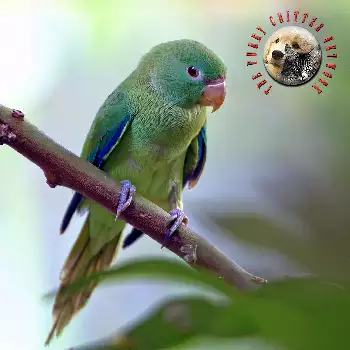Captivity
Intelligent and fearless, these curious little parrots can get into a lot of trouble if they are not supervised when out of their cage. Parrotlets are also very territorial and can attack other animals, especially other birds, even those much larger than themselves, if given the opportunity. While this does not mean they need to be the only pet in the household, they should be physically separated from other birds and pets for their own safety. They must also be trained from an early age to not follow their owners around or have free rein of the house.
Pet parrotlets are usually bundles of energy, spending hours swinging, climbing and playing with lots of toys that their cage should accommodate. Ropes, ladders, leather chew toys, bells, beads and rings are particular favorites. However, parrotlets have very strong beaks for their tiny size so it is important to be safe, strong toys. Buy toys designed for cockatiels and conures not budgies or finches.
Summary
Parrotlets are a species of the smallest New World parrots, comprising three genera. One of these genera, Forpus, is growing in popularity within the world of aviculture, raising interest in the group as a whole. Parrotlets are very small, with a stocky build and a broad tail, much like the lovebird species of East Africa and fig parrot and pygmy parrot species of Australasia. At 4 –5 inches(11-12cm) long, they are the smallest kind of parrot in the world.
The wild type coloring for this species is green, but several color mutations have been discovered through selective breeding. Parrotlets are sexually dimorphic, meaning males can be distinguished from females. Males have markings of cobalt blue on their head, wings and tail. Females generally lack these blue markings.
These miniature parrots in the wild travel in flocks which, depending on the species can range from as low as four to over 100 birds. Most either species travel in flocks of about 5–40. This species forms strong pair bonds with mates.
With a healthy diet, much exercise and healthy environment, the Parrotlet has a life expectancy of 10 to 20 years.
They can learn more than 10–15 words and can "whistle" songs well. They have about the same speaking and whistling capabilities of a cockatiel. They are also very good learners for commands such as "step up", "kiss-kiss", "step down", and other small commands. Some parrotlets can learn advanced tricks, but not as advanced as a Macaw or an African Grey Parrot. Having the ability to speak does not necessarily mean a bird will speak; it depends on the specific bird's personality.
These feisty little birds should not be overlooked in favor of more widely known types of birds; any Parrotlet owner will tell you that these birds possess all the intelligence and attitude of the largest of macaws. These birds are fairly quiet companions, making them ideal for those who live in apartments or condominiums. Males are more likely to talk than female parrotlets.
The most commonly kept parrotlet in aviculture is by far the Pacific Parrotlet, which now has several color mutations such as yellow, blue, lutino and white. The Mexican, Spectacled, and Yellow-Faced are also fairly common pets. Their popularity as pets has grown due to their small size and large personalities. Parrotlets are commonly known as playful birds that enjoy chewing as much as their larger Amazon Parrot counterparts. Being highly intelligent and active parrots, Parrolets must have ample opportunities to play and exercise. Environmental enrichment must be made a part of their lives as to prevent boredom. Parrotlets keep themselves more than occupied when left alone for several hours, so long as they are provided with an array of chewable and destructible toys to play with. However, when their keepers get home, they often greet them with lovely chirps and whistles to let them know they want attention.






